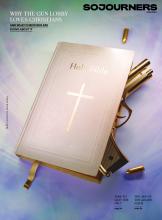REVELATION IS AN intimidating book of the Bible to understand, let alone apply to everyday life. Dense with symbolic imagery and metaphors, it has been subject to innumerable interpretations and far-flung theories. But what are we to make of startling moments in the text, like when Jesus regurgitates a sword or John eats a scroll? In Upside-Down Apocalypse: Grounding Revelation in the Gospel of Peace, author Jeremy Duncan walks readers through Revelation by drawing parallels between the genres and figures of speech of John’s day and ours, lending clarity to how John’s apocalypse is deeply steeped in Jewish literary tradition and Roman culture. When we ignore this context, we miss the point of the final book of the New Testament: Revelation is not the wrathful reckoning of a conquering king; rather, as Duncan writes, it’s a testament to “how the Prince of Peace turns violence on its head once and for all.”
With each chapter, Duncan decenters “chrono-centric” approaches to Revelation, encouraging readers to avoid reading the text as “a story about me and my world and my time exclusively.” As the perfect, timeless witness of God, Jesus must be the guiding principle by which we understand all of scripture. Only then can we appreciate how God’s kingdom in Revelation contrasts with earthly kingdoms fueled by oppression. “[E]very time you awaken to how empire is trying to steal your imagination and make you believe in violence,” Duncan writes, “you have rightly interpreted Revelation regardless of the time period in which you awake.” Revelation asks us to watch for injustice, wherever and whenever it appears.
Read the Full Article

